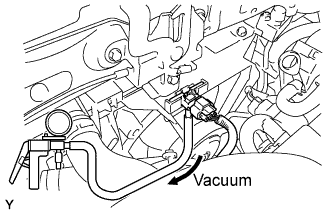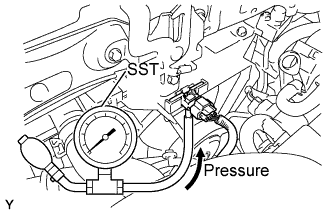Система Впуска -- Проверка Без Снятия С Автомобиля |
| 1. CHECK INTAKE SYSTEM |
Check that there is no air suction or leaks at the points shown in the illustration.
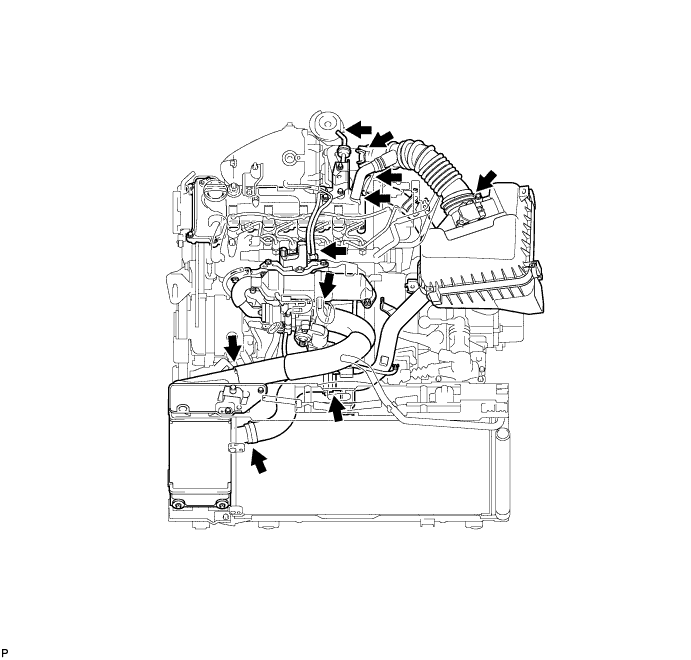
| 2. CHECK INTAKE AIR CONTROL SYSTEM |
Check for leakage or clogging between the air cleaner housing and turbocharger inlet, and between the turbocharger outlet and cylinder head.
Condition Operation Clogged air cleaner Clean or replace element Collapsed or deformed hoses Repair or replace Leakage from connections Check each connection and repair Cracks in components Check and replace
| 3. CHECK EXHAUST SYSTEM |
Check for leakage or clogging between the air cleaner housing and turbocharger inlet, and between the turbocharger outlet and exhaust pipe.
Condition Operation Deformed Repair or replace Foreign matter in passages Remove Leakage from components Repair or replace Cracks in components Check or replace
| 4. CHECK TURBOCHARGER PRESSURE |
Warm up the engine.
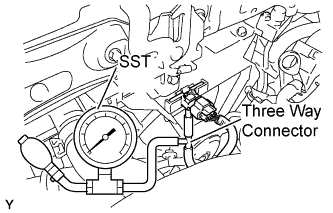 |
Using the three way connector, connect SST (turbocharger pressure gauge) to the hose leading to the intake air connector.
- SST
- 09992-00242
For Manual Transaxle
Depress the clutch pedal, and then fully depress the accelerator pedal. Measure the turbocharging pressure at maximum speed (approximately 5100 to 5250 rpm).
- Standard pressure:
- 15 to 45 kPa (0.15 to 0.46 kgf/cm2, 2.2 to 6.5 psi)
- If the pressure is less than the minimum, check the intake air and exhaust system for leakage.
- If there is no leakage, check whether the actuator hose is disconnected. If not, check the turbocharger.
- If the pressure is greater than the specified level, check whether the actuator hose is disconnected or cracked. If not, check the turbocharger.
For Multi-mode Manual Transaxle
Fully depress the accelerator pedal. Measure the turbocharging pressure at maximum speed (approximately 5100 to 5250 rpm).
- Standard pressure:
- 15 to 45 kPa (0.15 to 0.46 kgf/cm2, 2.2 to 6.5 psi)
- If the pressure is less than the minimum, check the intake air and exhaust system for leakage.
- If there is no leakage, check whether the actuator hose is disconnected. If not, check the turbocharger.
- If the pressure is greater than the specified level, check whether the actuator hose is disconnected or cracked. If not, check the turbocharger.
| 5. CHECK TURBINE SHAFT ROTATION |
Grasp the edge of the turbine shaft and turn it. Check that the turbine shaft turns smoothly.
If the turbine shaft does not turn or is difficult to turn, replace the turbocharger.
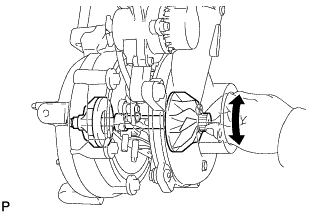 |
| 6. CHECK TURBO PRESSURE SENSOR |
Inspect the power source voltage.
Disconnect the turbo pressure sensor connector.
Turn the ignition switch to the ON position.
Using a voltmeter, measure the voltage between the terminals on the wire harness side.
- Standard voltage:
Tester Connection Switch Condition Specified Condition 1 (E2) - 3 (VC) Ignition switch ON 4.5 to 5.5 V
Turn the ignition switch off.
Reconnect the turbo pressure sensor connector.
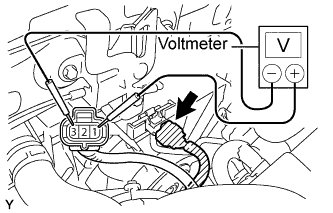 |
Check the power supply.
Warm up the engine.
Turn the ignition switch off.
Connect an intelligent tester to the DLC3.
Turn the ignition switch to the ON position and turn the tester on.
Select the following menu items: Powertrain / Engine and ECT / Data List / PIM.
Disconnect the vacuum hose from the turbo pressure sensor.
Apply negative pressure to the turbo pressure sensor and confirm that a vacuum occurs.
If the result is not as specified, replace the turbo pressure sensor.Using SST, apply pressure to the turbo pressure sensor and make sure that the pressure increases.
- SST
- 09992-00242
